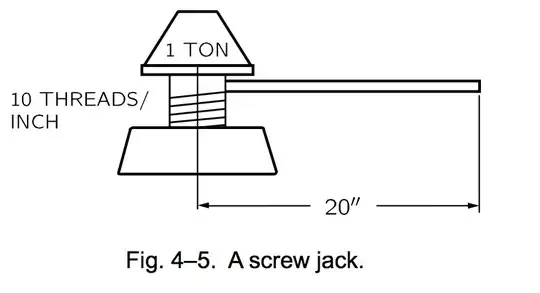I am trying to learn physics by myself as I do not have a good teacher at school. I've been reading Feynman Lectures on Physics and I can't figure out how he found out this number. Here is an excerpt of the book:
Let us now illustrate the energy principle with a more complicated problem, the screw jack shown in Fig. 4–5. A handle $20$ inches long is used to turn the screw, which has $10$ threads to the inch. We would like to know how much force would be needed at the handle to lift one ton ($2000$ pounds). If we want to lift the ton one inch, say, then we must turn the handle around ten times. When it goes around once it goes approximately $126$ inches. The handle must thus travel $1260$ inches, and if we used various pulleys, etc., we would be lifting our one ton with an unknown smaller weight $W$ applied to the end of the handle. So we find out that W is about $1.6$ pounds. This is a result of the conservation of energy.
If you divide $2000$ pounds by $1260$ in you get $\frac{100}{63}$, which is $1.58$, a number close enough to $1.6$ pounds, which according to Feynman is the weight that we need to apply to the end of the handle. I believe, however, that this calculation is wrong given a dimensional analysis of such operation.
Here is my dimensional analysis:
$\frac{2000 pounds * 1 in}{ 1260 inches }$ = $\frac{[M] * [L] }{[L]}$ = ${[M]}$ And this is wrong, as we are suppose to get a force, not a mass.
I found this website, where you can find what I think is an email from an student reporting the teacher that he believes he got the number diving $\frac{5}{\pi}$ . Can you also explain me this?
Finally, in a thread in a Physics Forum question,they concluded that $1.6$ is just the force to keep the system at equilibrium, and you need $\text{a force} > 1.6$ to actually lift the ton. After, someone said that Feynman would have said this answer is wrong. Why is that?
